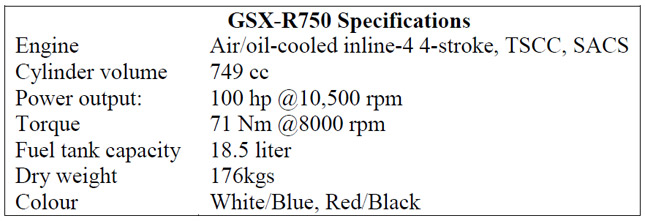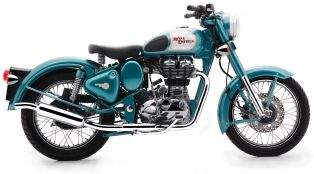 Different manufacturers may have played with ultra lightweight united to monstrous power, however was Suzuki, with its famous first GSX-R750 in 1985, that changed everlastingly the fundamental superbike mantra. It is considered as one the street legitimate racers, there had been various sports machines however the GSX-R750 was something else. It was a progressive bike with output like more than 100 hp power yield, under 180 kg dry mass, 55° inclining point, lightweight compound double-cradle perimeter frame, 18-inch wheels plan taking into account the streamlined design based on Formula 1 and Endurance racers.
Different manufacturers may have played with ultra lightweight united to monstrous power, however was Suzuki, with its famous first GSX-R750 in 1985, that changed everlastingly the fundamental superbike mantra. It is considered as one the street legitimate racers, there had been various sports machines however the GSX-R750 was something else. It was a progressive bike with output like more than 100 hp power yield, under 180 kg dry mass, 55° inclining point, lightweight compound double-cradle perimeter frame, 18-inch wheels plan taking into account the streamlined design based on Formula 1 and Endurance racers.
 Its motivation was the 1982 Endurance World Championship winning GS1000R XR41 racer. Its key element was to have a progressive ultra lightweight aluminium outline. In itself, aluminium casings were just the same old thing new; the claim was that, in principle, an aluminium casing was lighter and more grounded than the steel tube units that were than business as usual. The issue was creating an aluminium casing that could deal with moderately high strength in a financially savvy way.
Its motivation was the 1982 Endurance World Championship winning GS1000R XR41 racer. Its key element was to have a progressive ultra lightweight aluminium outline. In itself, aluminium casings were just the same old thing new; the claim was that, in principle, an aluminium casing was lighter and more grounded than the steel tube units that were than business as usual. The issue was creating an aluminium casing that could deal with moderately high strength in a financially savvy way.
 With the GSX-R, Suzuki engineers figured out how to fuse aluminium castings alongside expelled tubes to diminish the quantity of taps required for a casing. A run of the mill steel edge of the time had around 90 expressions, the fundamentally new GSX-R only 26.
With the GSX-R, Suzuki engineers figured out how to fuse aluminium castings alongside expelled tubes to diminish the quantity of taps required for a casing. A run of the mill steel edge of the time had around 90 expressions, the fundamentally new GSX-R only 26.The GSX-R750 was fundamentally a road legitimate and detuned variant of the GS1000R racer. The level slide carburettors gave quicker reaction to the throttle contrasted with the vacuum carburettors. It likewise required the rider to be all the more tenderly with the throttle. There were no bargains, it was fast in hands of an adroit rider yet could be experienced as apprehensive and even dangerous.
 That is absolutely the case in old and manhandled machines. The segments of the bike are all high calibre however ensure that the tires, suspension and course are all in great condition or the bike can unnerve the living sunshine out of you! The GSX-R750 motor is considered as solid yet we as a whole realize that there is no such thing as strong engines. The casing of the early models is not that inflexible and bend effortlessly when dropped.
That is absolutely the case in old and manhandled machines. The segments of the bike are all high calibre however ensure that the tires, suspension and course are all in great condition or the bike can unnerve the living sunshine out of you! The GSX-R750 motor is considered as solid yet we as a whole realize that there is no such thing as strong engines. The casing of the early models is not that inflexible and bend effortlessly when dropped.At the point when the GSX-R750 was revealed at the 1984 IFMA motorcycle show in Cologne it resembled no superbike ever constructed. Rather, it looked somewhat like the XR41 perseverance racer it was, to all plans and purposes, the world's first creation 'racer replica'.
The GSX-R's aluminium frame followed the lines of the racer's steel-tube item very closely, as did its dual headlights. And that racing heritage was also why the GSX-R sported an 18-inch front wheel at a time when 16-inch items were in fashion. That exotic aluminium frame, meanwhile, weighed a mere 18lbs, 19 fewer than the 1975 GS750's steel tube arrangement, and cost just $100 more to produce.
 Another purpose behind the light weight was the utilization of oil cooling. Air cooled motors' execution were constrained by heat, yet Suzuki engineers felt water cooling included an excess of weight and entanglement. So why not utilize the oil as of now in the sump? Suzuki distinguished the most basic areas to be cooled, expanded the oil limit, built up a double stage oil pump, and called it the Suzuki Advanced Cooling System (SACS).
Another purpose behind the light weight was the utilization of oil cooling. Air cooled motors' execution were constrained by heat, yet Suzuki engineers felt water cooling included an excess of weight and entanglement. So why not utilize the oil as of now in the sump? Suzuki distinguished the most basic areas to be cooled, expanded the oil limit, built up a double stage oil pump, and called it the Suzuki Advanced Cooling System (SACS).This cooling unit additionally supported the force by permitting smaller, lighter cylinders and higher pressure. Flat slide carburetors, as utilized until then as a part of motocrossers were utilized to enhance throttle reaction and fuel atomization. At long last, the new GSX-R likewise included the win Swirl Combustion Chamber (TSCC) head Design presented on the 1980 GS1100.
 Every one of this additional up to a radical, race ready looking machine with a dry weight of only 176kgs (9.5 kgs under the then AMA Superbike least weight point of confinement) and gloating an asserted 106bhp. Both numbers were progressive regarding power to weight and in spite of the fact that power figure was still 5bhp behind that of Yamaha's new five valve FZ750, the GSX-R weighed 25kgs less than the FZ and almost 45kgs less than Honda's VF750F Interceptor.
Every one of this additional up to a radical, race ready looking machine with a dry weight of only 176kgs (9.5 kgs under the then AMA Superbike least weight point of confinement) and gloating an asserted 106bhp. Both numbers were progressive regarding power to weight and in spite of the fact that power figure was still 5bhp behind that of Yamaha's new five valve FZ750, the GSX-R weighed 25kgs less than the FZ and almost 45kgs less than Honda's VF750F Interceptor.
 As far as straight line speed, the Suzuki compensate for having less power by having less mass, and equaled the Yamaha in the quarter mile and top speed. At corners its two nearest equals came no place close to the new Suzuki, it was the superbike to have out and about and the track.
As far as straight line speed, the Suzuki compensate for having less power by having less mass, and equaled the Yamaha in the quarter mile and top speed. At corners its two nearest equals came no place close to the new Suzuki, it was the superbike to have out and about and the track.


Picture Credits:
gsxr-suzuki.it
suzukicycles.org
Suzuki-gb
Total Motorcycle
By: Rakshit Shastry











